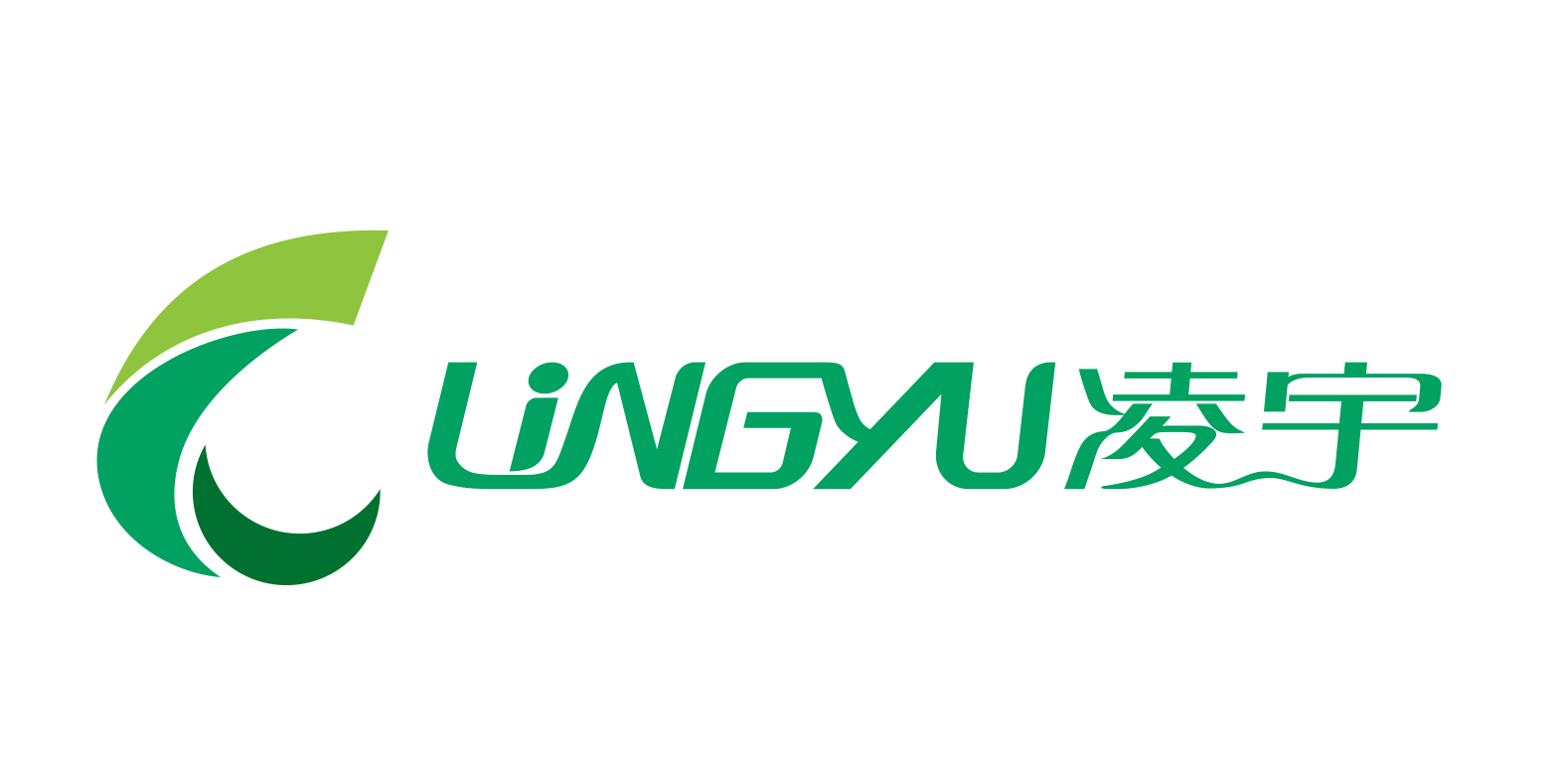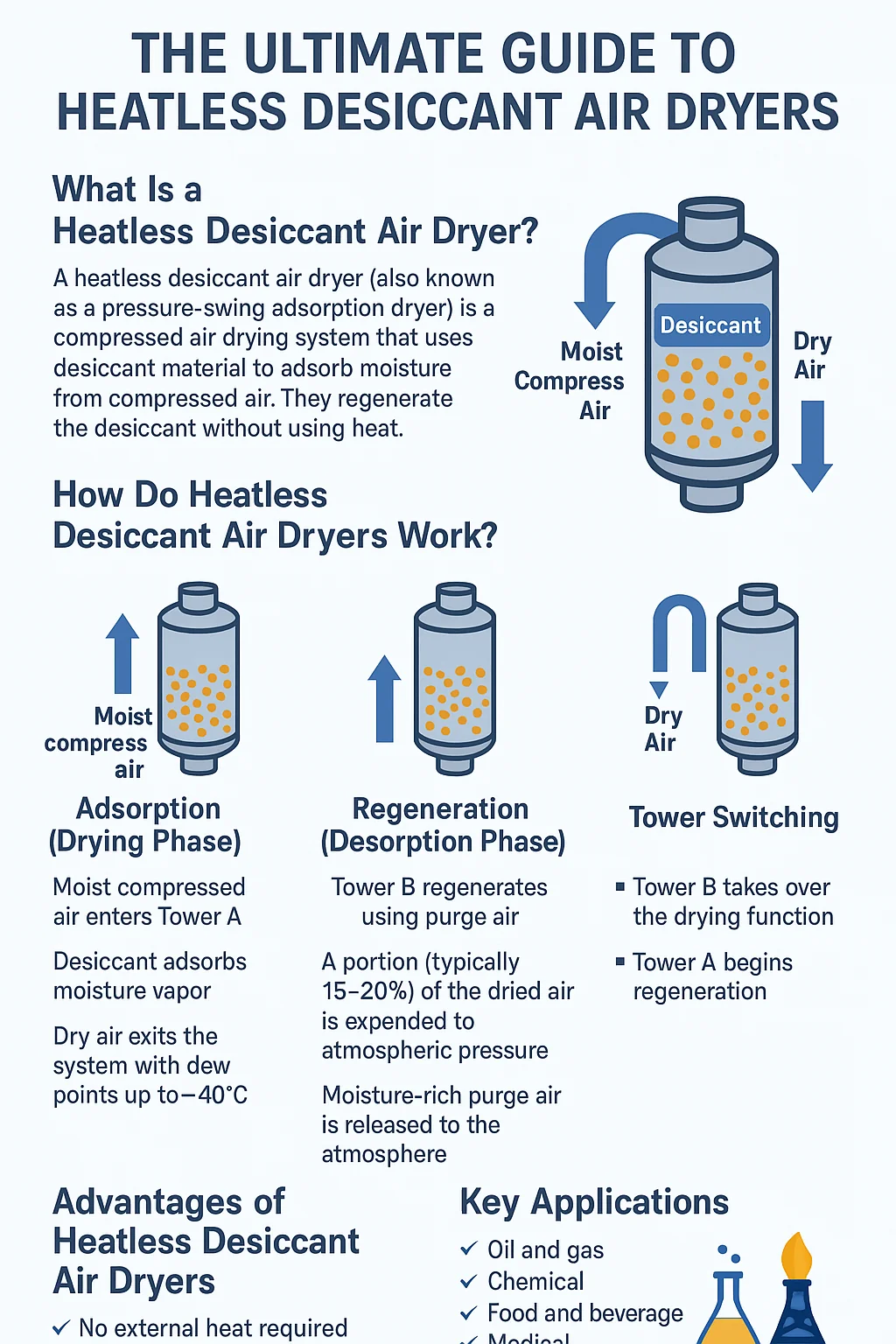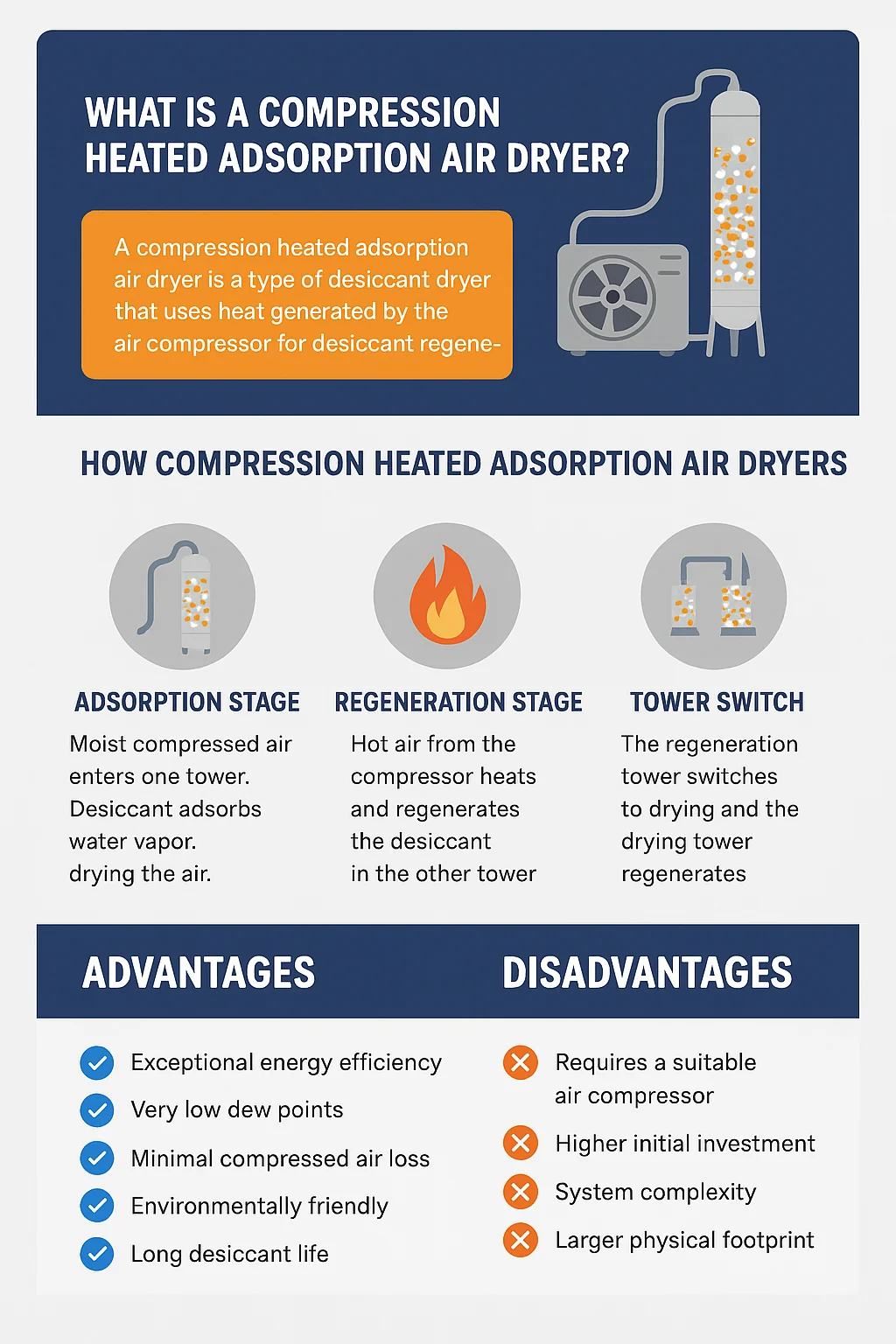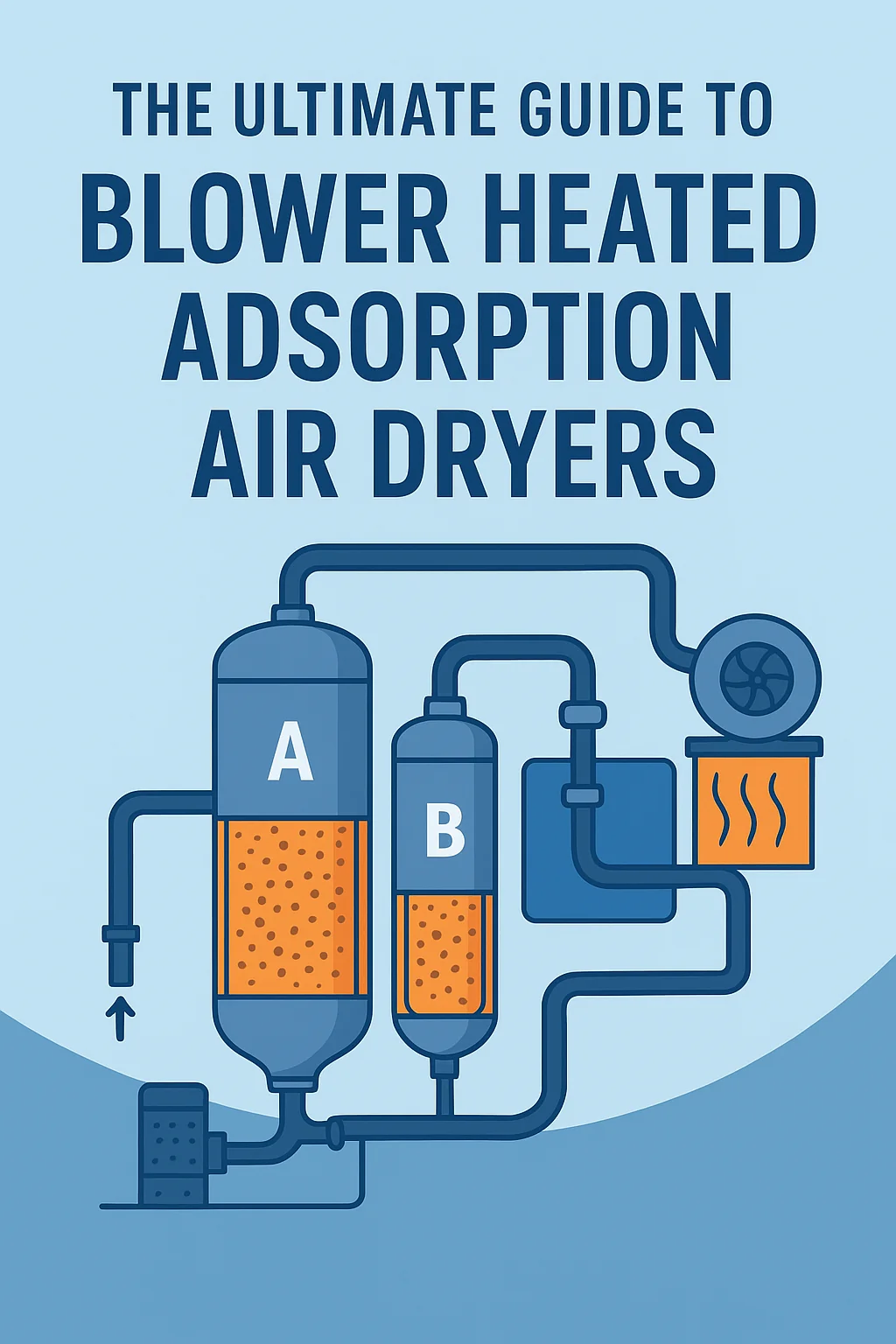Compressed air systems are vital to a wide range of industries—from pharmaceuticals and food processing to chemical plants, automotive facilities, and electronics manufacturing. While compressed air is an essential utility, it also contains moisture that can damage equipment, corrode pipelines, contaminate products, and disrupt sensitive processes.
To achieve low dew points and ensure clean, dry air, heatless desiccant air dryers are one of the most common and reliable solutions.
This ultimate guide explains how heatless desiccant dryers work, their benefits, limitations, applications, and what to consider when choosing the right system for your operation.
What Is a Heatless Desiccant Air Dryer?
A heatless desiccant air dryer, also known as a pressure-swing adsorption (PSA) dryer, is a compressed air drying system that uses desiccant material—such as activated alumina or molecular sieves—to adsorb (capture) moisture from the air.
What makes heatless dryers unique is that they regenerate the desiccant without using heat, relying purely on pressure changes and a small portion of dried purge air to remove moisture from the saturated desiccant.
Characteristics:
Two desiccant towers (Tower A and Tower B)
Delivers dew points as low as –40°C (standard) or –70°C for ultra-dry requirements
Uses 15–20% purge air for regeneration
No external heaters required
Simple, reliable, and suitable for harsh environments
How Do Heatless Desiccant Air Dryers Work?
Heatless dryers operate on a continuous two-tower adsorption/regeneration cycle.
1. Adsorption (Drying Phase)
Moist compressed air enters Tower A.
The desiccant adsorbs moisture vapor.
Dry air exits the system with dew points up to –40°C or below.
2. Regeneration (Desorption Phase)
Meanwhile, Tower B regenerates using purge air:
A portion (typically 15–20%) of the dried air is expanded to atmospheric pressure.
The low-pressure dry air absorbs moisture from the saturated desiccant.
Moisture-rich purge air is released to the atmosphere.
3. Tower Switching
Once Tower A becomes saturated:
Tower B takes over the drying function.
Tower A begins regeneration.
A controller manages the cycle time, pressure, and switching to maintain continuous dry air supply.
Advantages of Heatless Desiccant Air Dryers
✔ No External Heat Required
Simplifies design and reduces mechanical complexity.
✔ Extremely Reliable and Robust
No heaters, blowers, or complex controls—ideal for:
Remote installations
Cold climates
Harsh or variable environments
✔ Consistent Low Dew Points
Capable of dew points:
–40°C (standard)
–70°C (optional)
Suitable for critical processes like instrumentation and electronics
✔ Easy to Install and Maintain
Few moving parts mean:
Lower maintenance
Simple setup
Minimal downtime
✔ Works Well in Low Ambient Temperatures
No heater elements that struggle in cold conditions.
Disadvantages of Heatless Desiccant Air Dryers
✖ Higher Purge Air Consumption
Consumes 15–20% of dried compressed air for regeneration.
This increases energy costs for systems with high air demand.
✖ Higher Operating Cost Compared to Heated Dryers
Over time, purge-loss can cost more than energy used by heated models.
✖ Sensitive to Oil Contamination
Oil vapors can damage desiccant, requiring filtration and regular maintenance.
✖ Lower Efficiency for Large-Scale Operations
High purge-air losses make them less ideal for high-flow industrial systems.
Key Components of Heatless Desiccant Dryers
Desiccant towers
Activated alumina, silica gel, or molecular sieve desiccant
Inlet and outlet filtration
Check valves and switching valves
Controller / timer
Purge orifice
Diffusers
Moisture indicators or dew point sensors (optional)
Where Are Heatless Desiccant Air Dryers Used?
Heatless dryers excel in environments where reliability, low-temperature operation, or extremely dry air is required.
Common Industries
Oil and gas
Chemical and petrochemical
Food and beverage
Medical and pharmaceutical facilities
Electronics and semiconductor production
Automotive painting and powder coating
Power generation and instrumentation air
Typical Applications
Pneumatic control systems
Air-powered tools in cold environments
Drying air for laboratories or medical devices
Preventing corrosion in pipelines and control valves
Protecting sensitive sensors and actuators
Types of Heatless Desiccant Dryers
While all heatless dryers use PSA and purge air, variations include:
1. Fixed-Cycle PSA Dryers
Run on a standard timer (e.g., 10 min adsorption / 10 min regeneration)
Simple but not optimized for fluctuating moisture loads
2. Dew Point–Demand Controlled Dryers
Adjust cycle based on real-time outlet dew point
Reduce purge air usage
Lower operating cost
3. High-Pressure Heatless Dryers
Designed for pressures up to 350 bar
Used in PET bottle production and specialized industrial applications
4. Explosion-Proof or Hazardous-Area Models
Certified for ATEX or Class I/II environments
Required in oil, gas, and chemical industries
Purging Methods in Heatless Dryers
There are two primary purge strategies:
1. Fixed Purge
A constant percentage (15–20%) of dry air is always used
Simple but wasteful during low-load conditions
2. Variable Purge
Purge air adjusts based on humidity, flow, or dew point
Cuts energy cost significantly
Improves desiccant life
Key Considerations When Choosing a Heatless Desiccant Air Dryer
1. Required Dew Point
–40°C for standard industrial use
–70°C for ultra-dry applications (electronics, pharma, etc.)
2. Purge Air Loss
Factor purge air cost into total operating cost.
3. Flow Rate & System Size
Oversizing leads to unnecessary purge loss; undersizing fails to meet dew point requirements.
4. Desiccant Type
Activated alumina: most common, durable
Silica gel: high adsorption capacity
Molecular sieve: best for ultra-low dew points
5. Filtration
To protect and extend desiccant life:
Pre-filter (oil removal)
Particulate after-filter
6. Ambient Temperature
Heatless dryers excel in cold environments, unlike heated models.
7. Installation & Maintenance
Consider:
Valve accessibility
Tower design
Cycle-time configuration
Availability of service parts
Maintenance Requirements
Heatless dryers require consistent but straightforward maintenance:
Replace desiccant every 3–5 years depending on air quality
Check and service valves and seals
Replace inlet and outlet filters regularly
Inspect purge orifice and check valves
Monitor dew point performance
Maintain clean, oil-free compressed air supply
Good maintenance ensures stable dew points and long equipment life.
Advantages Compared to Heated Regeneration Dryers
| Feature | Heatless Dryer | Heated Dryer |
|---|---|---|
| Regeneration Method | Purge air only | Heater + purge/blower |
| Purge Air Use | Higher | Lower |
| Complexity | Low | Medium–High |
| Best For | Small–medium flow, cold climates | Large flow, energy optimization |
| Initial Cost | Lower | Higher |
| Operating Cost | Higher (purge loss) | Lower (but more maintenance) |
Conclusion
Heatless desiccant air dryers are a proven, reliable solution for achieving low dew points in compressed air systems. They require no external heating, making them simple to install, operate, and maintain—even in harsh or cold environments. Although they consume more purge air and have higher operating costs than heated regeneration dryers, their reliability and simplicity make them highly popular in many industries.
By understanding how they work, their advantages and limitations, and key selection considerations, you can choose the ideal heatless desiccant dryer for your air system—ensuring dependable, clean, and dry air for years to come.








